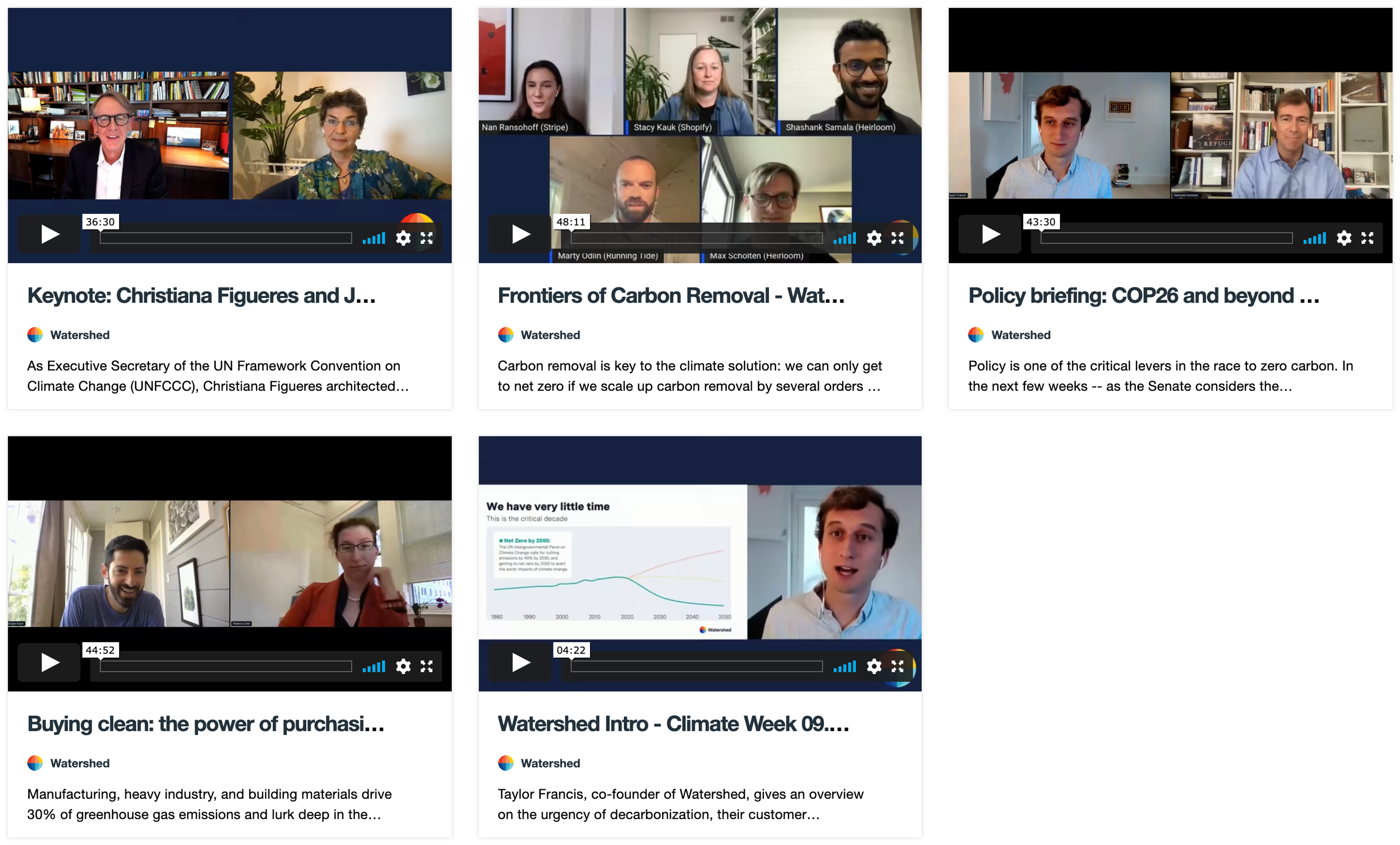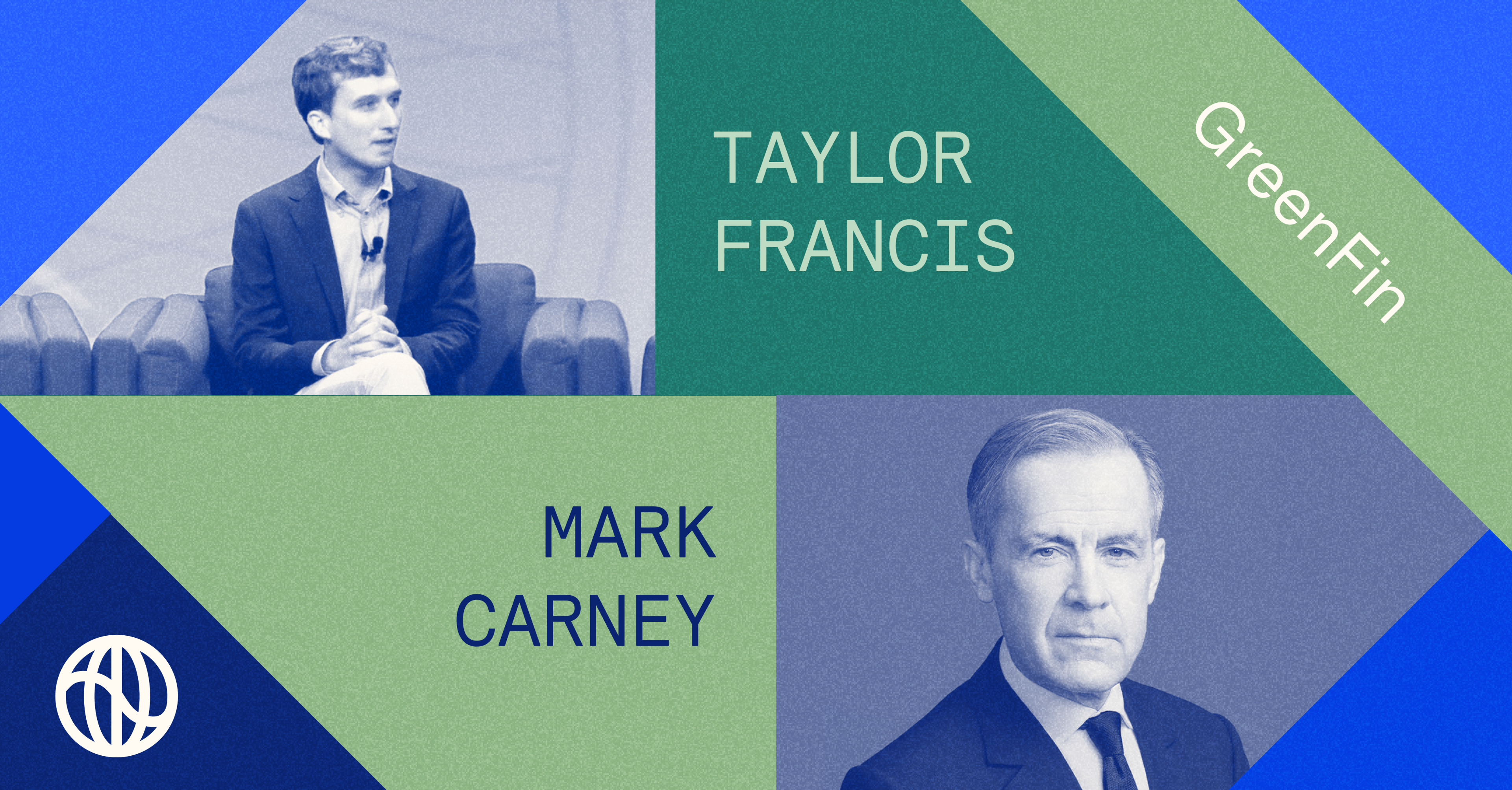We recently hosted a Climate Week event on the policies and technologies that really matter for decarbonization. We started with a keynote with Christiana Figueres, architect of the Paris Agreement, and then went deep on carbon removal, policy, and clean procurement.
The big takeaway: we have to go faster. We have until just 2030 to bend the carbon curve and get global emissions down by half. A new month starts tomorrow: we have only 99 months left. This recap covers the highlights of how companies can use their next few months to make real progress on climate action.
Full recordings available here. Thanks to the hundreds of climate leaders who participated, and to all those who followed up with great notes and questions.

The keynote
John Doerr, chair of Kleiner Perkins and a Watershed board member, interviewed Christiana Figueres, architect of the Paris Agreement and founding partner of Global Optimism.
Architecting success
When Christiana took over the UN climate negotiations after the failed 2009 Copenhagen talks, her first step was getting a third-party analysis of all that went wrong. When she received 300 pages of feedback, her team then pored over each page obsessively for years. The result? A unanimous agreement of 195 countries in Paris—not just on the key principles, but on every paragraph, word, and comma.
Six years later
Some good news since the Paris Agreement—many organizations have made pledges to be net zero by 2050, including:
- Governments representing 75% of global emissions
- Financial institutions representing half of the world's assets under management
- Thousands of large companies, including 200+ with 2040 pledges
But it’s not enough. She emphasized that "we're walking in the right direction, but not walking fast enough.”
2050 is the hard deadline for the world to reach net zero to avoid the worst impacts of climate change. 2040 would be better, by a lot. But the most committed companies now have 2030 goals, knowing that momentum builds on itself and that every avoided catastrophe matters.
Getting tactical
Christiana shared a playbook for how companies can have an impact in this fight. At minimum, every company should have a plan to measure, reduce, and remove carbon from their supply chains, along with a public net-zero goal.
From there, they can bring their supply chains along. Every company “inherits” the emissions of their suppliers, but also has leverage over them. If those suppliers want to keep that business, companies should make that conditional upon decarbonization.
Stubborn optimism
Christiana’s closing thought:
“Our planet is like a sick loved one right now. Devastation is in sight. But we need to move from lamenting to action, fully believing that we have the ingenuity and determination within ourselves to really help—to gather the technology, the funding, and the policy we need to save those we love from the worst of climate change.”
Breakout #1 - Buying Clean: the Power of Purchasing
Shayle Kann, partner at Energy Impact Partners and host of the clean energy podcast The Interchange, interviewed Rebecca Dell, former Obama advisor and current Industry Program Director at the ClimateWorks Foundation.
Bending cost curves
Green premiums are the extra costs of buying low-carbon alternatives. But these premiums are often lower and less consequential than outdated reputations would suggest. Many products can be decarbonized for modest markups now, and consumers are increasingly happy to pay.
Companies can also drive green premiums down further through laws of scale. If these businesses—especially as part of a buying alliance—invest thoughtfully into cleaner processes and inputs, those costs will drop, sometimes below that of high-carbon options.
Leverage points
Just three core building materials—cement, steel, and basic chemicals—account for ~20% of greenhouse gas emissions. But we can remove the dirtiest ingredients from cement and make steel with hydrogen today. We know how. We just need to scale the best solutions, fast.
Low-hanging fruit is everywhere. We can electrify more things, and make that electricity clean. We can substitute in lower-carbon ingredients, components, and methods. And companies can ensure this happens today just by insisting on it down their supply chains.
(Interested? Read more about how companies can buy clean electricity in a high-impact way.)
Breakout #2 - The Frontiers of Carbon Removal
The founders of Running Tide and Heirloom, two cutting-edge carbon removal startups, chatted with the climate leads at Stripe and Shopify, who’ve collectively kickstarted the market with $10m+ of purchasing commitments.
The future is competitive
Running Tide and Heirloom aren’t speculative non-profits. They’re tech companies with customers, investors, deliverables—and competitors. They’re not chasing symbolic results. They’re out to beat other smart, well-funded startups chasing the same north star.
One key metric: energy efficiency. How much power will they burn removing each tonne of carbon? The best will have to challenge what the laws of physics allow, and use clean power to do it. And the first startups to do this at scale will reap enormous rewards.
The power of early investment
The costs of removing carbon today are significant, at up to a few thousand dollars per tonne. But just as the costs of solar power have dropped 2,000x since the late 60s, the floor here will be much, much lower—perhaps under $100 this decade.
How will we get there? More companies need to be like Stripe and Shopify and pre-purchase future removal today. These bets are unlocking the R&D and scaling we need, where good ideas can be rapidly tested, iterated, and eventually turned into repeatable blueprints.
(Curious to learn more about high-impact investments into carbon removal? Let us know.)
Breakout #3 - Policy: COP26 and Beyond
Taylor Francis, co-founder of Watershed, interviewed Nat Keohane, former White House climate advisor and President of the Center for Climate and Energy Solutions.
A change in tactics
What did Team Obama learn from their climate efforts? When talking about policy, don’t lead with technical discussion. Set the stage by talking about how the policy is going to make people’s lives better, in concrete ways they can see in the real world. Then get into the how.
When blocked on congressional consensus, they also switched focus to executive regulation. There are always things we can do while waiting on political progress. Companies can set their own targets above official requirements, fund needed R&D, and take meaningful action together.
Aggressive goals are contagious
When the Biden Administration released their most recent 2030 goals, the US had just reached 13% in reductions from 2005, led by 33% in cleaner electricity generation. But it’s not enough to be making progress: we need to push harder, and to push others to come along with us.
This is why Biden sent John Kerry to press global peers for better commitments at COP26, the upcoming UN climate summit. Whenever a country strengthens their goal, it becomes harder for every remaining country to hide behind weaker goals—which is equally true of companies.
The future at stake
Nat also gave an insightful breakdown of the state of two pending pieces of legislation—the infrastructure bill and the reconciliation bill—both of which could have profound impacts on the climate if passed. Companies can still influence those outcomes. Watch more here.







